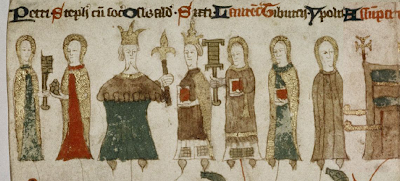
Welcome to August! And welcome, as well, to my new monthly feature, a month-by-month look at medieval feast calendars.* Without further ado, here’s a sampling of five of the many saints whose feasts you ought to be celebrating this month:
August 5th: St. Oswald of Northumbria
Oswald was a warrior-king with a penchant for giving to the poor. According to Bede, St. Aidan witnessed his charity and blessed his right hand so that it would always be strong, and apparently, even after death, it remained whole and uncorrupted. According to Reginald of Durham, a bird–possibly a raven–carried his arm off. The tree where the bird lived also became incorruptible, and when the arm fell out and on the ground, a spring sprung. His body was held at Bamburg, but the magic arm was later stolen by monks and taken to Peterborough. Still later, at least four different churches that missed the memo about the magic arm claimed to have possession of his magic head.
Since his right arm was magic, Oswald is represented in Christian iconography as a king who’s missing his right arm, naturally. Celebrate Oswald’s feast day by not using your right arm for the entire day.
August 10th: St. Lawrence of Rome
Lawrence was put to death on a gridiron, which is to say he was suspended between metal grills and roasted over a fire. According to legend, halfway through his ordeal he told his tormentors “Assum est, inquit, versa et manduca” or “This side’s done; turn me over and take a bite.”
Celebrate the martyrdom of the patron saint of prostitutes, comedians, librarians, and chefs with a backyard cookout.
August 19th: St. Magnus the King
St. Magnus the King was never actually king of anything but the Earldom of Orkney. He was chiefly famous for refusing to fight the Vikings out of Christian piety, instead staying in his ship and singing the Psalms. Later, he was sentenced to death by political rivals, but when it came time for his beheading, the executioner refused, out of respect for aforesaid Christian piety. So a cook was brought in to do the deed instead.
You should probably celebrate the Feast of St. Magnus the King by refusing to celebrate and instead staying home and singing the Psalms. Or possibly by having your cook inexpertly chop the head off of something.
August 24th: St. Bartholomew
One of the apostles, he traveled to India after the resurrection and was later flayed alive in Armenia. Thus, he appears in medieval art as a bloody corpse holding his own skin and the knife that flayed it off. Cripes, medieval Christians, could you be more gruesome? (That’s him in the middle of the image above.)
Celebrate St. Bartholomew’s Day by visiting the local abattoir, or by going to see whichever sequel to Saw is currently in the theaters, or, if you’re squeamish, with a plate of TGI Friday’s Loaded Potato Skins.
August 29th: The Decollation of St. John the Baptist
St. John is so important a saint that he gets multiple days, and oddly enough, the anniversary of his beheading is the least gruesome of them. On February 24th, you can celebrate the first and second discoveries of his severed head, which was hidden on the Mount of Olives after his death, buried, but later dug up, reburied, re-dug up, and re-re-buried. Then there’s May 25th, which honors the re-re-digging up, or the third discovery of his severed head, which was afterward taken to Constantinople.
Since you’ve probably still got the head you had your cook chop off on the Feast of St. Magnus the King, round up a few more heads and have yourself a gruesome Easter Egg Hunt, only with decapitated heads instead of eggs. It’ll be riotously good fun for the whole family.

Other saints to venerate in August include St. Augustine of Hippo, St. Sixtus II, St. Felix, St. Peter, St. Stephen, St. Tiburtius, and St. Hippolytus, as well as the Assumption of the Virgin.
—
*Just a side note: I’ll be relying pretty heavily on Bodleian Library MS Rawl. D 939 for the first few entries. Thus, the calendar will be very biased towards England in the 14th century, until I have time to hunt down a few more good calendars from elsewhere that are easily available on the web. If you know of any, send them my way.







Recent Comments